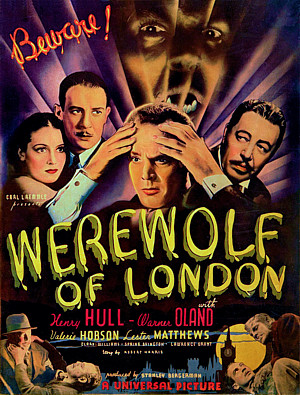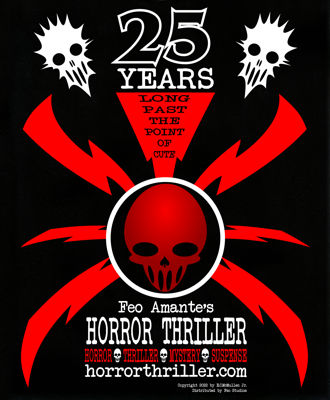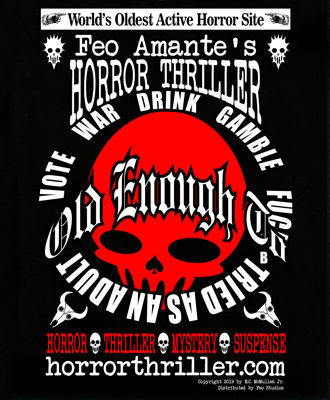 |
 |
Review by E.C. McMullen Jr. |
|

WEREWOLF OF LONDON- 1935USA Release: May 13, 1935 Carl Laemmle, Universal Pictures Ratings: USA: N/A |
|||
Deep in the heart of Tibet, which looks astoundingly like Vasquez Rocks in Southern California (10 miles from the junction of Highway 5 and Highway 14. Get off on the exit that reads, Vasquez Rocks!), some Asians are arguing about something in Amish Asianish. Then they take up their argument with some guys who speak their language and English. Before the whole thing gets ugly, all are distracted by a man riding a llama, led by another man. This frightens the Tibetans away, as Tibetans frighten easily (but they'll be back, and in greater numbers!).
The man on the llama turns out to be a Catholic Priest and wishes them Pax Vobis cum. The two men are botanist Dr. Wilfred Glendon (Henry Hull) and his adventurer friend, Hugh Renwick (Clark Williams). They are looking for the rare Tibetan flower, Mariphasa Lupino Lumino; said to take its nourishment only from the moon. But the flower is also said to grow t high mountainous elevations in a demon haunted place and even the Priest calls Wilfred and Hugh fools (Oh yeah? So what the hell is the Priest doing there?). But he suffers fools gladly and bids them another Pax Vobis cum.
"You are foolish, but without fools there would be no wisdom."
As the two men venture deeper into the demon haunted valley, they experience some weird stuff which culminates in Dr. Glendon beating the crap out of a werewolf, but not before he is bitten himself.
Folks back in 1935 may not have been aware of what werewolf bites could lead to, but nearly 80 years later, we sure do. Could have been worse though, he could have been bitten by a rabid werewolf. Or even worse, a rabid zombie.
At least Dr. Glendon got his Mariphasa whatsit out of the deal and he goes back home to study it.
In his lab, Dr. Glendon has invented an electric light that replicates moonlight (a sunlamp in other words). With this he grows more Mariphasa flowers. His fun loving wife, Lisa (Valerie Hobson: MYSTERY OF EDWIN DROOD, BRIDE OF FRANKENSTEIN, BLANCHE FURY, THE HIDEOUT) works hard to pull him away from his work and have a life with her. This day is a garden party and Dr. Glendon and his fellow botanists are showing off their rare plants, the showcases of which are Venus Fly traps and a Madagascar plant (which eats slightly larger animals including small mammals).
The party is hosted by one of many comedy reliefs in this picture and this one is Lisa's aunt, Miss Ettie Coombes (Spring Byington). Through the daft Miss Ettie's bubbly ignorance we learn of the social world that Lisa Glendon travels in and Wilfred married into.
Miss Ettie meets up with Paul Ames (Lester Matthews: THE WICKHAM MYSTERY, THE RAVEN [1935], MYSTERIOUS MR. MOTO, THE MYSTERIOUS DOCTOR, THE INVISIBLE MAN'S REVENGE, THE SON OF DR. JEKYLL, SAVAGE INTRUDER), who is back from America and visiting his snooty old grandmother, Lady Forsythe (Charlotte Granville). Soon Ettie has scuttled off with Paul for a whirlwind tour of the garden party, its unusual plants, and a quick introduction to the cast of characters.
Lisa Glendon happily meets Paul, who is an old childhood friend. Miss Ettie notices Dr. Glendon's jealousy, and frivolously stokes it, creating awkward tension between Wilfred, Lisa, and Paul.
TRIVIAThough actor Warner Oland was born in Sweden and Caucasian by both parents, his natural features, most prominently his eyes appeared so Asian that even Chinese actors mistook him for a fellow countryman. Warner (real name Johann) came to believe that it must be due to Mongolian blood from the time of the Mongol invasion of Europe. |
Later, Dr. Glendon meets Dr. Yogami (Warner Oland: THE STUDIO MURDER MYSTERY, THE MYSTERIOUS DR. FU MANCHU, THE RETURN OF DR. FU MANCHU, BULLDOG DRUMMOND STRIKES BACK), a fellow botanist. When Glendon asks if they had met before, Yogami tells him that they met briefly in Tibet where they were both on the same mission: searching for the elusive phosphorescent Mariphasa Lupino Lumino.
Meanwhile, Paul notes that the once gay Lisa is no longer gay. She used to be so gay. What happened? Lisa tells him to shut up.
During an egghead discussion in the parlor, Dr. Yogami speaks of werewolves to Dr. Glendon, who quickly lowers his respect for Yogami. Glendon is a man of science, not superstition, and won't cotton to such horsefeathers! Yogami meaningfully mentions that he knows of two cases of Werewolves - right now - in London. The Mariphasa flower is the antidote to the affliction.
Back in his lab, Dr. Glendon works feverishly to make the Mariphasas bloom beneath his electric moonlight. It soon becomes clear that Dr. Glendon and his waving off Yogami's concerns was a ruse. Glendon is well aware of his encroaching affliction.
Tomorrow is the first night of the full moon.
As Wilfred ignores his wife, Lisa holds a salon and winds up with another party invitation. Dr. Yogami shows up and his exotic Japanese features excites the attention of Miss Ettie, who invites "Dr. Yokohama" to her party. Yogami isn't there for parties, but to beseech Dr. Glendon for a look at his Mariphasa flower. Glendon, unnerved by his affliction and keeping it secret from all, distrusts the inquisitive Yogami and gives him another brush-off. Yogami isn't fooled however, and tells Wilfred in no uncertain terms that the werewolf's nature is to kill those it loves best.
So frightened by the physical transformation that is slowly coming over him, Wilfred is both verbally cruel and obsequious to his wife. Lisa doesn't know what to make of it. She knows he is lying but cannot begin to understand what about. "What about that, Wilfred?" All she knows is that he came back from Tibet a changed, colder man. After three weeks of his attitude, she's near her breaking point. Paul knows an opportunity when he sees it and tries to cash in on the rift.
Wilfred has been keeping his complete transformation at bay with the use of the Tibetan flower, but when he returns to his lab that evening, he discovers that someone has clipped all of the blooms, only unopened buds remain.
In 1935, Universal Pictures, unsure of how far they could push the newly formed board of censorship, played their werewolf movie out like DR. JECKYL and MR. HYDE. When Wilfred changes into a werewolf thanks to Special Effects by John P. Fulton, it is highly stylized and fashionably hairy (widow's peak and sideburns). Except for the bottom jaw tusks (wolves have tusks?) this werewolf merely looks like a scruffy man who thought to brush his hair before going out (his hair is perfect). Moreover, the werewolf version of Wilfred is British enough not to leave his domicile until properly attired.
While THE WEREWOLF OF LONDON is one of the tamest versions of werewolves I've seen, it's not without its scary moments.
The Art Direction by Albert S. D'Agostino (ISLE OF THE DEAD, BEDLAM, THE THING FROM ANOTHER WORLD [1951]) creates believable environments that enrich the scares, and Charles Stumar's cinematography (THE HUNCHBACK OF NOTRE DAME [1923], THE MUMMY [1932], THE RAVEN [1935]) takes excellent advantage of it.
Unfortunately those moments are often hampered by lead actor Henry Hull. At the time he was a celebrated stage actor, accustomed to exaggerating his movements and expressions for the back row. Director Stuart Walker (MYSTERY OF EDWIN DROOD), working from a script by John Colton (THE INVISIBLE RAY), chose too many close-ups of Wilfred's Henry's facial expressions - while looking directly into the camera - which appear more like cartoonish mugging than genuine emotion. Colton's script, based upon the original story by Robert Harris, also forces the light comedy too much, making it feel grafted and unnatural.
This was Universal Pictures first full length Werewolf movie and it took a decided Science Fiction tack. Not getting the result they hoped for, UP hired an actual scientist and best selling science fiction writer, Curt Siodmak (DONOVAN'S BRAIN) to write a Supernatural version and THE WOLF MAN (1941) was the hit.
Beyond its archival quality, THE WEREWOLF OF LONDON is dated in effect and tale, though not in concept. This movie is ripe for remake.
Two Shriek Girls.


This review
copyright 2012 E.C.McMullen Jr.

|
| DRESS NICE | |
FEO AMANTE'S HORROR THRILLERCreated by:E.C.McMullen Jr. FOLLOW ME @ |
| Amazon |
| ECMJr |
| Feo Blog |
| IMDb |
| Stage32 |
| Twitter X |
| YouTube |
| Zazzle Shop |

